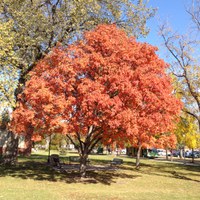Dakota Gardener: Life and death, and life again
(Click an image below to view a high-resolution image that can be downloaded)
By Joe Zeleznik, Forester
NDSU Extension
I love autumn, although I usually get rather nostalgic at this time of year.
The days are getting shorter awfully fast.
Preparations for winter are moving along quickly. It’s been a great year for acorns at our place, and the squirrels are busy with their hoards and caches. Many people – our household included – are frantically doing end-of-the-summer canning.
The leaves have started changing color and it’s a joy to see the red of the sumac shrubs, the orange of our sugar maples and the wide variety of yellows that are coming along. The trees’ roots and stems are packed full of sugar and starch that will fuel next year’s growth. That is, if the trees survive the winter.
And the vast majority of them will survive. A few, though, might not make it. But let’s not worry about that quite yet.
With the leaves losing their shades of green, the trees also are bringing nitrogen back into the branches and stems. The chemistry behind fall colors is a fascinating story of sugar and tiny molecules of pigment that capture and reflect light. The colors develop more fully – brilliantly – when days are sunny and dry. Cloudy, wet weather will give us only drab fall colors.
Believe it or not, many conifers are shedding their leaves as well. The older, inner needles of pines, spruces and arborvitaes are turning yellow or orange and dropping to the ground. These needles have been shaded out and aren’t productive any more, so the trees are letting them go.
Each fall, I get a phone call or an email about a “pine tree” that’s losing all of its needles, completely dying. Usually, the tree is a larch, which is a very unique conifer. It’s deciduous.
Every year, larch trees shed all of their needles. Every last one. They turn a bright yellow, providing a stunning display before they drop to the ground. And it’s normal. Larch trees are the exceptions to the rule – evergreens that are barren in the winter.
It’s a part of the tree’s annual cycle of life and dormancy, and life again.
But it doesn’t end there. The trees and other plants are feeding the ecosystems around them. The fallen leaves get broken down by bacteria and fungi, which are fed on by small insects and other invertebrates. Those small insects are eaten by larger insects or perhaps by mice or voles, or even garter snakes.
And through all those processes, more nitrogen and other nutrients go back into the soil, where they’ll be utilized in next year’s growth. It’s a fascinating process.
Next spring, the trees will shake off dormancy, pulling the sugar from their roots and nitrogen from their branches and the soil, developing new green leaves to start the whole cycle over.
But I’m getting ahead of myself. Now’s the time to slow down and wait.
For more information about gardening, contact your local NDSU Extension agent. Find the Extension office for your county at https://www.ag.ndsu.edu/extension/directory/counties.
NDSU Agriculture Communication - Sept. 22, 2020
Source: Joe Zeleznik, 701-231-8143, joseph.zeleznik@ndsu.edu
Editor: Ellen Crawford, 701-231-5391, ellen.crawford@ndsu.edu




